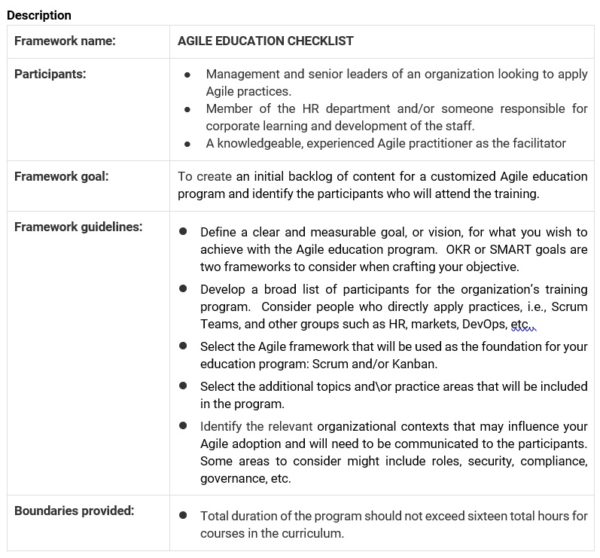Agile adoption is serious business. The adoption process requires new ways of working — and new ways of thinking about work — that can disrupt any organization.
However, as an Agile coach, I’ve seen few organizations give serious thought to planning how they will educate their employees in this new way of working. In this article, I will share some lessons I have learned and how to put these lessons into action in your Agile training program. Additionally, I have provided a simple, downloadable framework to define your Agile training needs so that you have a better idea on who you should educate, what should be taught and when to teach it.
When Best Practices Go Wrong
In 2015, I was the Agile coach for the video advertising group of AOL. There were twelve teams in this part of the organization, ten using Scrum and two using Kanban, and I was the only coach. They were new to Agile and I wanted them to be successful. At the time, a common approach to starting a new Agile team was “learning by doing.” Under the guidance of an experienced Agile coach, new teams would learn new ways to approach their day-to-day responsibilities and little-by-little become more Agile.
Since this was considered a best practice, and is still a common approach today, my plan was to start by engaging four of the Scrum teams with one-on-one coaching along with training tailored to their specific needs. Once the initial teams had demonstrated their competency, I would move to a new set of teams. I was absolutely certain this was the correct strategy for a multi-team Scrum adoption — and I was completely wrong!
As the only Agile coach, I could only be in one place at a time. That meant that while four teams were getting care and one-on-one attention, the remaining eight teams and the organization as a whole received very little of my time. Every time one of the initial four Scrum teams started to achieve some sort of cadence, an outside event, or a non-coached team, would pull them back into their old ways of working.
After about two months, with four teams struggling to gain any traction, I came to the realization the rest of the organization didn’t truly understand Agile, Scrum or Kanban and the four teams didn’t have enough language and tools to explain it to the rest of the organization. Yes, this part of AOL had “gone Agile.” However, going Agile was based upon a superficial understanding provided by out-of-date blog posts, inaccurate YouTube videos and a loose set of guidelines provided by management. Using Agile words and participating in Agile events was not the same as truly understanding Agile.
Once I recognized this, I stepped out of my normal coaching routine to address the broader issue. I worked with senior leadership to create a two-day Agile workshop to address common misunderstandings. We rolled out this workshop to 150 people and the effects were swift and positive: teams saw an immediate increase in delivery of value, the percentage of planned work completed in each Sprint rose dramatically and Kanban teams saw a marked jump in throughput of value. Added to that, communication between teams, Product Owners and stakeholders was improved. Most importantly, engagement and happiness of the staff increased across the board.
Lessons You Can Apply to Your Agile Training Program
This experience taught me three important lessons.
- Educate everyone at the same time. If you only educate a couple of teams, then the teams won’t have the necessary shared vocabulary and understanding. In order for Agile to succeed, people need the ability to describe what they are doing with a common vocabulary and shared understanding of their destination. An uneven distribution of Agile knowledge and practices makes any Agile adoption weak.
- Education is important at all levels. If managers are not involved in the training, they may still reach for classic reporting structures, assign work to individuals instead of teams, and/or continue to emphasize individual efforts rather than team efforts.
- Educating early is vital. With the Agile manifesto nearly twenty years old and the first Scrum teams closer to thirty, it can be easy to think “we know what Agile is.” That mindset can be the first mistake in a failed Agile adoption. Ensuring education is early can prevent bad habits from being continued and brings everyone up to the most current knowledge and learning available.
Four Keys to an Effective Agile Training Program
Here are my four recommended ingredients for building an Agile training program:
- Start with a strong foundation: establishing a common foundation in a single Agile framework, like Scrum or Kanban, is critical. Even if the organization ends up using more than one framework, having everyone trained on at least one framework creates the common vocabulary essential for success. Most often, that starting foundation is Scrum.
- Layer on additional practices: experience has shown that for Agile adoptions to succeed, teams need to deliver a working software in short intervals. Scrum and Kanban, out-of-the-box, allow this to happen. Don’t replace parts of these Agile frameworks with a “roll your own” Agile process. Instead, layer on additional practices to enhance the experience. I like to think of these additional practices as reinforcing a foundation with rebar. Some key practices I often recommend with Scrum are: information radiators, a common set of metrics, relative estimation techniques and fundamentals of Product Backlog refinement.
- Mix in organizational context: with a hat size of 7 7/8 I know for a fact “One Size Fits All” doesn’t. Since companies are as unique as people, any program of Agile education should reflect the uniqueness of the organization. After creating and reinforcing the foundation, look to the specific context of the organization to see how the unique flavor of the organization can be added to the Agile training recipe. Sometimes this can be as simple as defining a common Sprint Review agenda used by all teams.
- Don’t cut corners: whenever the topic of education and training comes up in our engagements, we invariably hear some variation of, “We don’t have time for training.” No matter how much time we propose, the request back is always for less time. Since these objections are so common, organizations often adopt a piecemeal, or a compressed, approach. Resist the urge to adopt one of these methods for the following reasons:
- With a piecemeal approach, the curriculum is broken up into small modules and delivered over some predefined period of time. This looks good on paper but there is a potential danger that employees never establish a learning rhythm. In addition, important concepts may not be taught until well after they are needed. In my experience, application and retention of new information and practices is often low with the piecemeal approach.
- With a compressed approach, the organization recognizes the need for education while simultaneously minimizing the disruption caused by training. Consequently, whatever curriculum needs to be communicated to the employees ends up being crammed into whatever timebox that has been selected by management. In our experience, when education is compressed the biggest impact is reduced retention. This method almost always requires the heavy use of lectures, slides, and powering through them so you can get done in time. You may as well just ask the class to read the slides offline for the value they will get.
Download our Agile Education Checklist to use in planning out the education for your next Agile project.
Recap
Who should be taught? Agile Training should be distributed evenly across all teams in order to give a common vocabulary and shared understanding, this includes all levels of management.
What should be taught? Start with a strong foundation in a single Agile framework. Don’t replace parts of these Agile frameworks with a “roll your own” Agile process. Instead, layer on additional practices to enhance the experience. Then, mix in content specific to your organization.
When should education take place? Early education is better. Don’t cut corners with the timing of the training. Avoid the pitfalls of compression or piecemeal training.
Need More Guidance?
Developing a successful Agile Training program is not easy. If you think you could benefit from expert advice, please contact us to speak to one of our Agile transformation experts.






